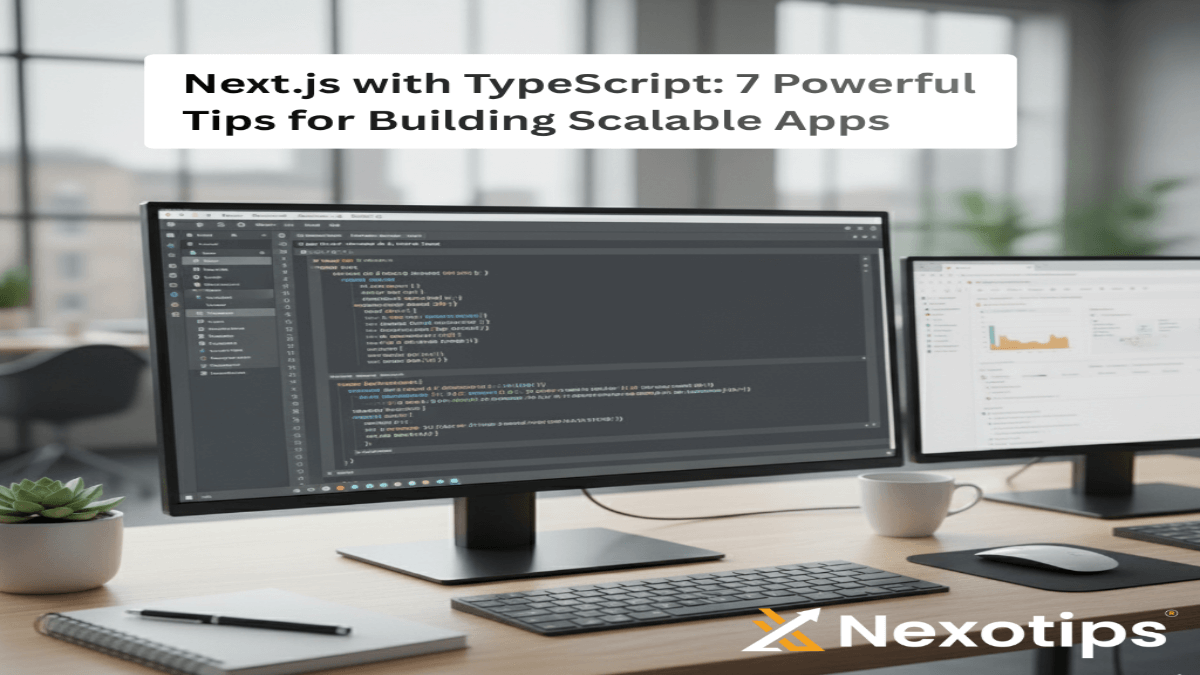
Next.js with TypeScript: 7 Powerful Tips for Building Scalable Apps
Discover how to build scalable, high-performance applications using Next.js with TypeScript. At Nexotips Infotech, we share 7 powerful tips to help developers master Next.js with TypeScript for modern web development in 2025. Whether you’re building enterprise-level platforms or fast-growing startup projects, this guide will help you make your apps more reliable, maintainable, and efficient.
In today’s fast-paced tech world, developers need frameworks that make it easier to build fast, reliable, and future-ready applications. That’s exactly where Next.js with TypeScript shines — combining the flexibility of React with the power of static typing to deliver scalable, production-grade web apps.
Table of Contents
1. Use Next.js with TypeScript for Type Safety and Fewer Bugs
When working on large Next.js with TypeScript applications, bugs often come from data type mismatches or unclear code structures. TypeScript eliminates that by adding static typing to your project.
You’ll know the shape of your data before runtime, leading to fewer errors and better team collaboration. Next.js with TypeScript also enhances IntelliSense support in VS Code, enabling developers to write code more efficiently with intelligent suggestions.
To dive deeper into the language, check out the TypeScript Official Docs.
2. Optimize Components for Reusability
A scalable app depends on reusable and modular components. In Next.js with TypeScript, design each component to handle specific logic or UI behavior.
Define prop types using TypeScript interfaces. This not only improves code readability but also ensures consistency across your project.
interface ButtonProps {
label: string;
onClick: () => void;
}
const Button = ({ label, onClick }: ButtonProps) => (
<button onClick={onClick}>{label}</button>
);By keeping components atomic, your app becomes easier to maintain and expand.
3. Leverage Static and Server-Side Rendering Wisely

One of Next.js’s greatest strengths is its hybrid rendering capability — Static Generation (SSG) and Server-Side Rendering (SSR).
- SSG is ideal for pages that don’t change frequently (like blogs or docs).
- SSR suits pages that depend on dynamic data (like dashboards).
Choosing the right rendering method can drastically improve both SEO and performance.
You can learn more about these approaches in our detailed guide — Next.js Rendering Explained.
4. Implement API Routes for Clean Backend Logic
Next.js API Routes allow you to build a lightweight backend inside your frontend project. This is perfect for small to medium-sized applications.
By writing TypeScript in API routes, you ensure consistent request and response types across your app. This makes debugging easier and reduces runtime errors.
Example:
import { NextApiRequest, NextApiResponse } from 'next';
export default function handler(req: NextApiRequest, res: NextApiResponse) {
res.status(200).json({ message: 'API is working fine!' });
}This simple structure helps you scale your backend without switching technologies.
5. Use Environment Variables for Configuration

As your project grows, you’ll need different configurations for development, staging, and production. Using .env Files helps you keep credentials secure and maintain a clean setup.
In Next.js with TypeScript, environment variables are accessed via process.env. Prefix client-side variables with NEXT_PUBLIC_ to make them accessible in the browser.
NEXT_PUBLIC_API_URL=https://api.nexotipsinfotech.comThis keeps your code secure, readable, and environment-independent — a must for scalable apps.
6. Optimize Images and Code Splitting
Next.js offers a built-in Image Optimization component that automatically resizes and serves images efficiently. Always use the <Image /> component instead of regular <img> tags.
Example:
import Image from "next/image";
<Image src="/images/cover.jpg" alt="Next.js with TypeScript tutorial" width={800} height={400} />This helps reduce load time and boosts Core Web Vitals. Additionally, Next.js automatically splits your code into smaller chunks, improving load speed for large applications.
7. Monitor and Analyze Performance Regularly

Even the most optimized apps can slow down as they scale. Use tools like Lighthouse, Vercel Analytics, or Google PageSpeed Insights to track and improve performance.
In Next.js with TypeScript, monitoring builds and analyzing bundle sizes is easy using the built-in next build --analyze command.
Regularly refactor code, optimize third-party libraries, and keep dependencies updated.
Conclusion
Building scalable applications isn’t about writing more code — it’s about writing smarter code.
Using Next.js with TypeScript gives you both flexibility and safety to develop modern, maintainable, and lightning-fast apps.
At Nexotips Infotech, we help businesses build high-performance web solutions using modern frameworks like Next.js.
Want to learn more? Check out our other coding-related blogs on the Nexotips blog.
